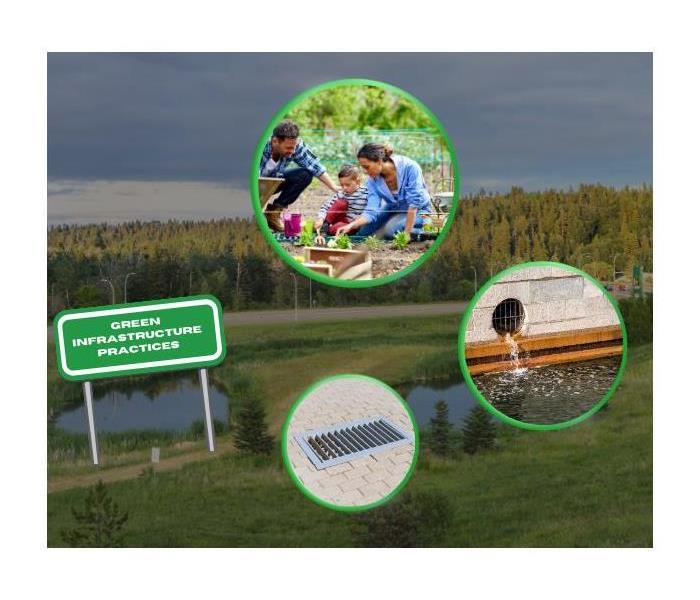6 Essential Tips to Mitigate Flooding Risks in West Valley City, UT
5/18/2024 (Permalink)
West Valley City, nestled in the picturesque Salt Lake Valley, is a vibrant community that faces its share of weather-related challenges, notably flooding. With its unique geographical features and seasonal climate patterns, the city occasionally experiences flooding, posing risks to property, infrastructure, and public safety. However, with proactive measures and community involvement, residents can significantly reduce the impact of flooding events. In this article, we'll explore six essential tips to mitigate flooding risks in West Valley City, UT.
1. Understand the Geography and Drainage Systems:
The first step in mitigating flooding risks is to understand the geography and drainage systems of West Valley City. Being situated in a valley means the city is prone to flooding, especially during heavy rainstorms or snowmelt. Residents should familiarize themselves with the local topography, including low-lying areas and nearby water bodies such as streams, rivers, and retention basins. Additionally, knowledge of the city's drainage infrastructure, including stormwater drains and retention ponds, is crucial. Understanding how water flows through the city helps residents identify potential flood-prone areas and take appropriate precautions.
2. Maintain Clear Drainage Pathways:
One of the most effective ways to prevent flooding is to ensure that drainage pathways remain clear and unobstructed. Residents should regularly inspect and maintain gutters, downspouts, and storm drains on their properties to prevent debris buildup, which can impede water flow during heavy rainfall. Additionally, keeping streets and sidewalks clear of leaves, branches, and other debris helps maintain efficient surface drainage. By taking proactive measures to keep drainage pathways clear, residents can minimize the risk of localized flooding in their neighborhoods.
3. Implement Green Infrastructure Practices:
Green infrastructure refers to nature-based solutions designed to manage stormwater and reduce flooding risks. In West Valley City, residents can implement green infrastructure practices on their properties to help absorb and infiltrate rainwater, reducing the volume of runoff entering the stormwater system. Examples of green infrastructure techniques include installing rain gardens, permeable pavement, and vegetated swales. These features not only enhance the aesthetic appeal of neighborhoods but also provide ecological benefits by promoting biodiversity and improving water quality.
4. Invest in Flood Protection Measures:
For residents living in flood-prone areas or near water bodies, investing in flood protection measures is essential. This may include installing flood barriers, such as sandbags or flood gates, around homes and businesses to prevent water intrusion during flood events. Elevating electrical systems, appliances, and valuables above potential flood levels can also minimize damage. Additionally, retrofitting buildings with waterproofing materials and backflow prevention devices can help mitigate flood risks. By taking proactive steps to protect their properties, residents can minimize the financial and emotional toll of flooding disasters.
5. Participate in Community Flood Preparedness Efforts:
Flooding is a community-wide issue that requires collective action to address effectively. Residents can participate in community flood preparedness efforts by joining neighborhood associations, attending local workshops, and engaging with city officials and emergency management agencies. By staying informed about flood risks and evacuation procedures, residents can better prepare themselves and their families for potential emergencies. Community involvement also fosters resilience and strengthens social cohesion, enabling neighborhoods to effectively respond to and recover from flooding events.
6. Support Sustainable Development Practices:
As West Valley City continues to grow and develop, it's essential to prioritize sustainable land use and development practices that mitigate flooding risks. This includes implementing stormwater management regulations, preserving natural floodplains, and promoting low-impact development techniques. By integrating green infrastructure into new construction projects and retrofitting existing infrastructure to improve resilience, the city can reduce its vulnerability to flooding while enhancing environmental sustainability. Residents can support sustainable development practices by advocating for responsible land use policies and participating in planning processes that prioritize flood resilience.
Flooding poses significant risks to communities, but proactive measures can help mitigate these risks and build resilience. In West Valley City, residents can take several steps to reduce the impact of flooding events, from understanding the local geography and drainage systems to investing in flood protection measures and supporting sustainable development practices. By working together as a community and implementing these essential tips, residents can minimize the threat of flooding and ensure a safer, more resilient future for West Valley City, UT.






 24/7 Emergency Service
24/7 Emergency Service
